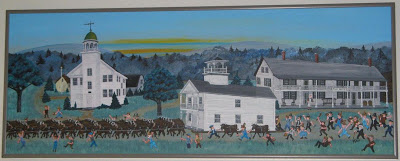On August 10, 1835, the committee of
Canaan residents eliminated a public nuisance from their town. With
help from residents of nearby Enfield, Hanover and Dorchester, they
ripped Noyes Academy right off its foundation, eliminating once and
for all the specter of interracial education in Canaan, New
Hampshire.
On the morning of August 10, all roads
led to Canaan. When the sun rose, a few men began appearing on
Canaan Street. By the middle of the morning, a steady stream of
rowdy men with axes and iron bars became a mob gathered in the center
of town. A contingent from Enfield had brought a string of 50 oxen,
which added to the noise and confusion. That first day, they were
not able to pull the Academy Building down because the chains they
had brought kept breaking. The next day they were more successful.
They hitched the team of oxen to the building and pulled the building
off the foundation. Although it was a slow, difficult process, the
crowd pulled the building down the street, stopping at Currier and
Wallace's store, where they demanded the store owners give them rum.
On August 10th and 11th, the crew that was
attacking Noyes Academy was fed with beef paid for out of the town
treasury.
The weather that week was scorching
hot. William Wallace, in “The History of Canaan” says the
temperature got up to 116 degrees. When the crew pulling the Academy
building made it to Parson Fuller's house, they stopped to get some
water from his well. The parson's wife ran out and cut the rope to
the bucket so they couldn't use it. Mrs. Wallace also came out of
her house and started yelling at them.
Once they had succeeded in dragging
the building to the corner of the town square, many in the mob didn't
go home. Drunk on rum, they ran around the village shouting
obscenities and threatening to attack the houses where the black students were staying.
Wallace quotes from a letter written
by one of the town's people during that time. Unfortunately he
doesn't tell us who wrote the letter. In the letter, the writer
comments that “Mr Kimball was absent during all this storm”,
which is not surprising. It is a little surprising that Wallace
picks this quote to share. The writer of the letter goes on to say
that the whole thing was a feud between the Masons (Jacob Trussell
and Elijah Blaisdell) and the anti-Masons (George Kimball, Nat
Currier and Hubbard Harris).
The Academy building was left on a
corner of the town square, where it blocked the road. Muster day was
always held in September, and on September 10, Canaan combined muster
day and relocation of the Academy building. Everyone who had been
involved the month before, including the team of oxen, returned to
Canaan and moved the school building to the Baptist Parsonage Field.
After that was accomplished, they took the town cannon, dragged it
through the streets of Canaan and fired at every house owned by a
Noyes Academy supporter, breaking glass and causing damage at each
home.
The Academy building sat in the field
by the Baptist Parsonage for four years. Finally, when the town got
sick enough of having to look at an eyesore, someone burned it down
in early March of 1839.
What was at the root of all the
trouble in Canaan over Noyes Academy? Was it a feud between two
competing lawyers? Was it a feud between the Masons and the
Anti-Masons, like Wallace's letter writer suggests? It's too bad
Canaan's older students couldn't have had a way to complete their
education. The original idea behind Noyes Academy was to provide a
way for Canaan's students to prepare for college. Then George
Kimball comes up with the idea that the new school should admit black
students. This was admirable, but common sense would have to tell
you this was not going to fly in this small town in New Hampshire,
especially the way it was presented to the people of the town. If
they had focused on their original intent, and invited a few black
students to join the school, rather than focusing on the interracial
aspect of the school, they might have been able to pull it off. If
things had gone well, they could have had more black students join in
later years. It's annoying that two of the biggest troublemakers had
no commitment to Canaan and no children to educate. Although Elijah
Blaisdell had grown up in Canaan, he lived in Lebanon at the time,
and spent the rest of his life in Lebanon. George Kimball left
Canaan very soon after the destruction of the Academy. He went west
to start a business. Nathaniel Currier gave him $6,000 as start-up
capital. Kimball's business failed, and he ended up finally
returning to Bermuda. Kimball was always one to get really involved
in causes, having been very involved in church and religious issues,
and also quite involved in the temperance movement. Nathaniel Currier
stayed in Canaan, ran his store, and stayed involved in the attempt
to provide the older children of Canaan an opportunity to get an
education.


No comments:
Post a Comment